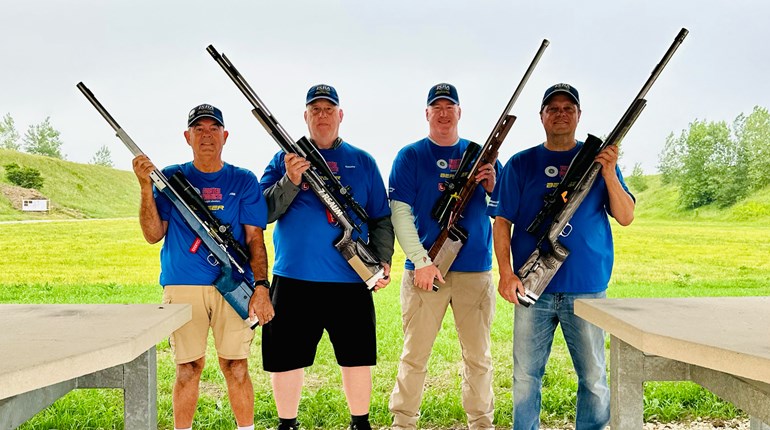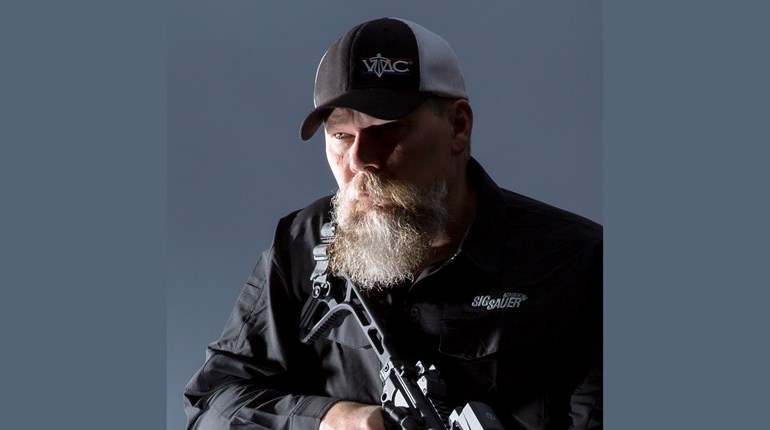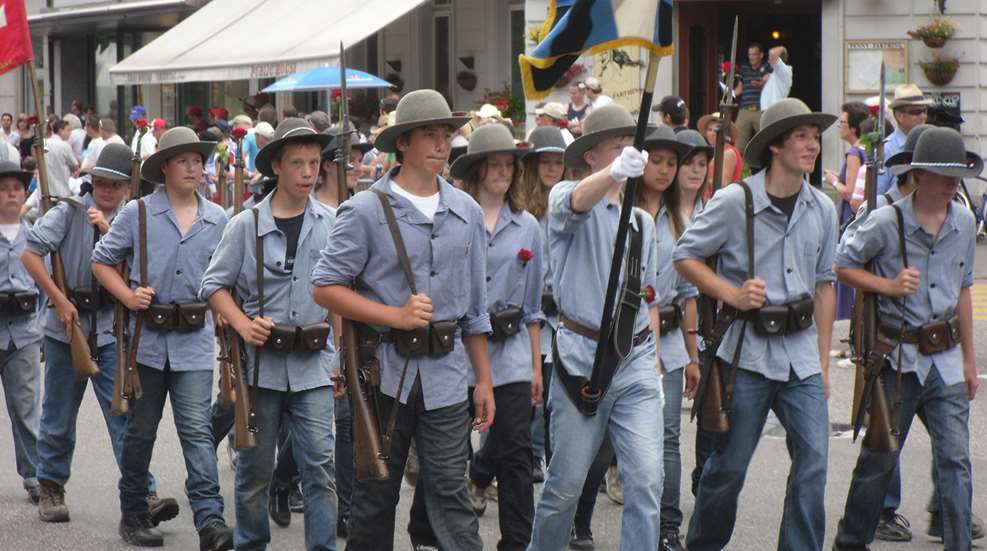
Note: Written in 2010, this article anticipated a vote by the Swiss people on the Anti-Gun Initiative, which took place on February 13, 2011, resulting in its defeat by 56 to 44 percent. However, while the Swiss are not in the European Union (EU), they are in the Schengen Agreement with the EU, which protects trade and security. The EU has now demanded that Switzerland adopt the new EU firearm restrictions, which requires extensive licensing. Faced with this EU blackmail, on May 19, 2019, the Swiss voted 64 to 46 percent to adopt a watered-down version of the restrictions. Despite that, the shooting traditions are deep rooted and are sure to persist. I’ll report on that after I participate in the next Schuetzenfest in 2020.
Two boys bike uphill on the town’s main street with .22 cal. bolt-action rifles strapped across their shoulders wearing blue shirts and old-fashioned gray hats. Starving after an all-night flight from the U.S., I am sitting outside a deli in Lenzburg, former home of Hammerli precision arms. Kids on bikes with guns? I know I’m in Switzerland!
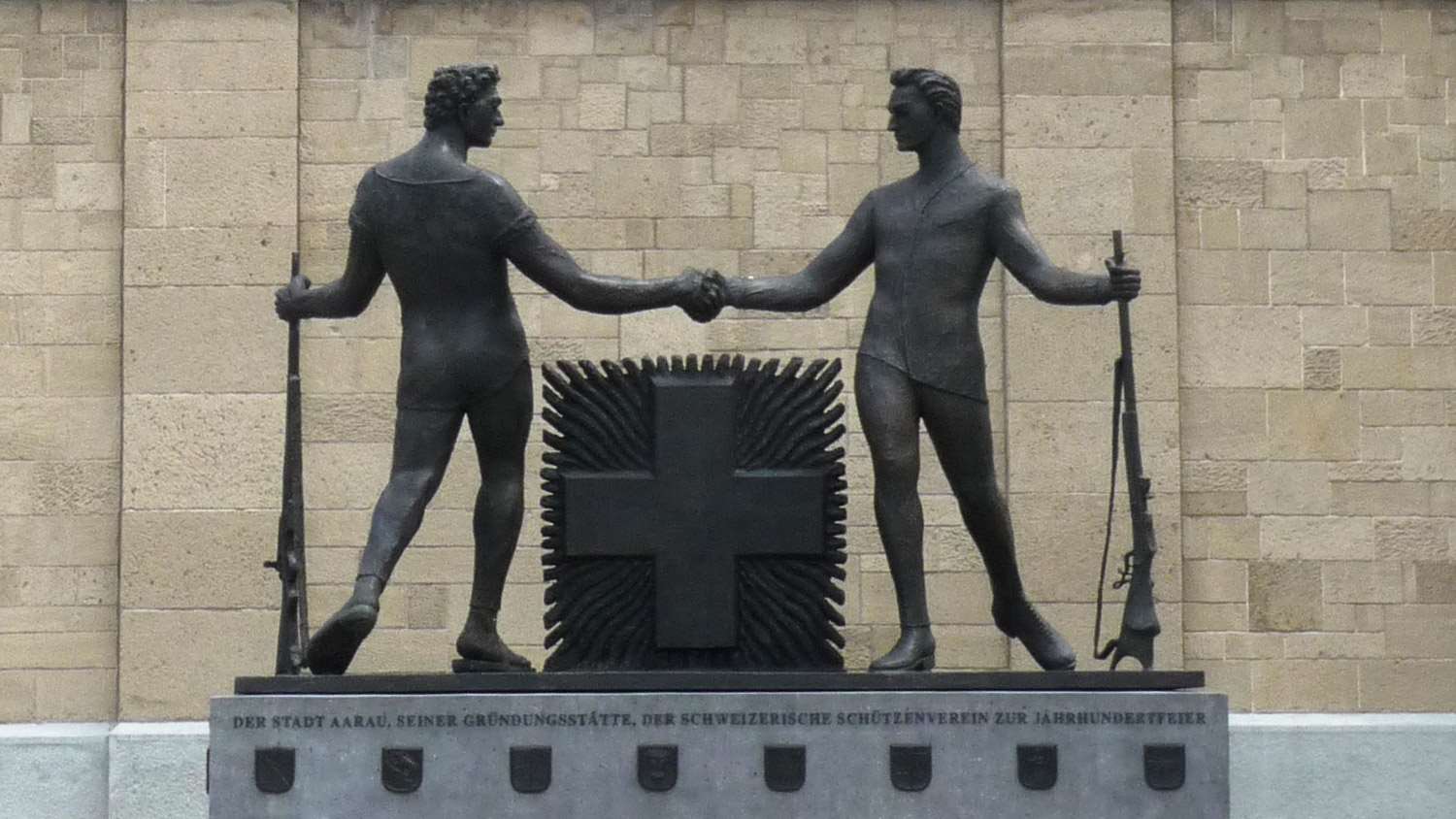
The largest rifle shooting match in the world is held every five years in a different region of the Swiss Alpine republic, which in four weeks of Summer of 2010 included 43,000 competitors—37,000 in rifle and 6,000 in pistol. Some 3.5 million cartridges were shot. The Schuetzenfest took place in several shooting ranges near Aarau, a town in the German-speaking part of the country (other regions speak French, Italian, or Romanish, a Latin derivative). Our Swiss Rifles Club—which includes former NRA president Sandy Froman—participated on July 1-4, 2010.
Youth Shooting Day, which took place before we arrived, featured 1,800 youngsters competing—mostly with the current Swiss service rifle, the Strumgewehr 90 (Stgw 90, or assault rifle model 1990). It shoots the low-recoil 5.6 mm Swiss cartridge, which is almost identical to the 5.56 mm NATO round and is perfect for the two youth age categories: under 16 and under 20. Who says kids and guns don’t mix? Their sport trains them for citizenship.
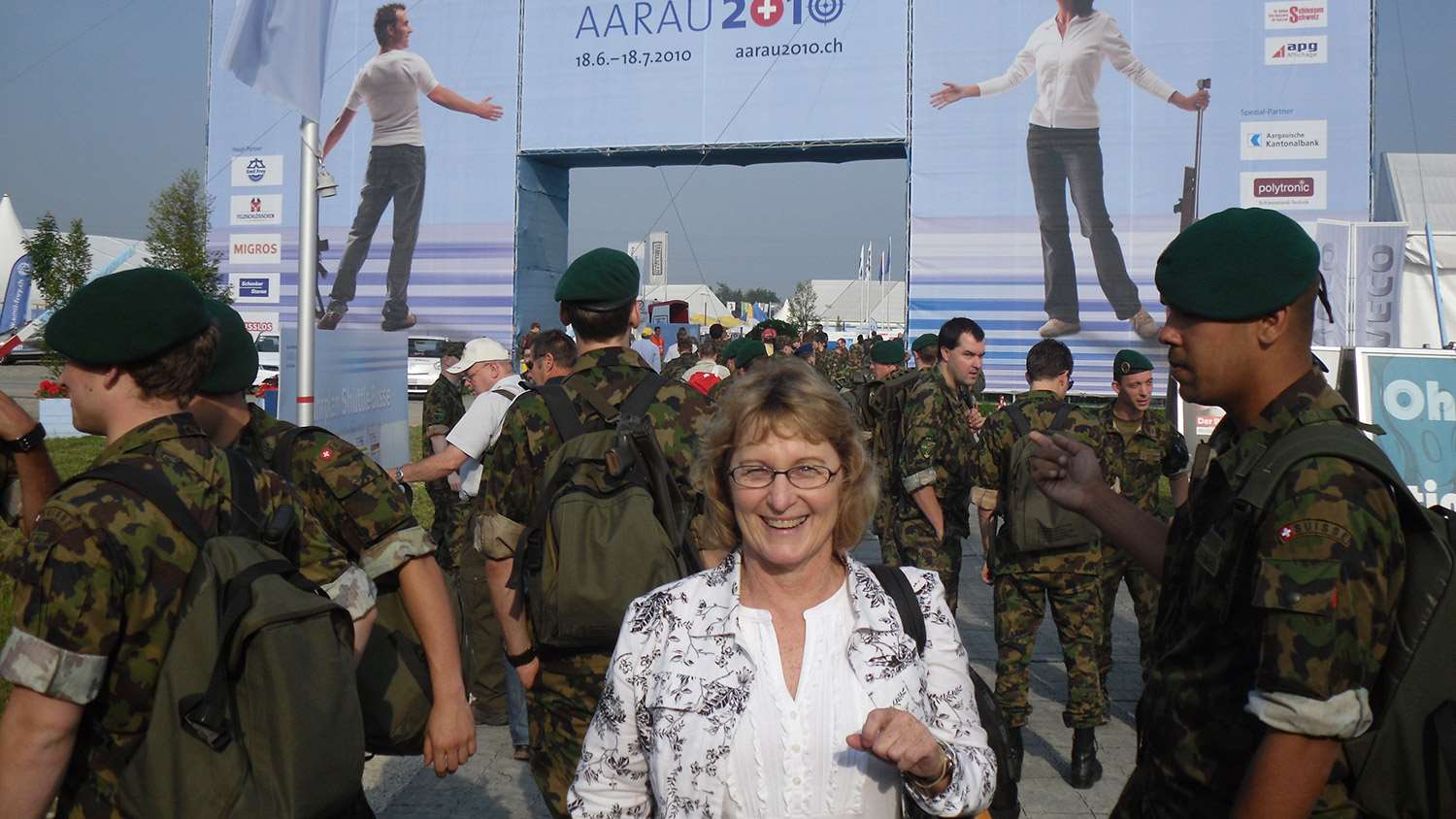
July 1 is competition day for the Swiss Militia Army, and our first day to shoot. Switzerland has no standing army, and instead has a militia force consisting of all able-bodied males from the time they turn 20 (and females who volunteer), when they are issued a service rifle to keep at home. As for private gun ownership, the Swiss and the Finns are two of the highest in the world. The Swiss voted against membership in the European Union, which continues the tradition of the European monarchies of repressing gun ownership. They are still, as James Madison wrote in The Federalist, “afraid to trust the people with arms.”
Since the founding of the Swiss Confederation in 1291, her armed populace defeated all of the great powers of Europe headed by monarchies. Her example gave confidence to the Americans who revolted against the British Empire in 1776. The prospect of a gun in every hand, including a sniper behind every Alpine crevice with orders that any announcement of surrender is enemy propaganda, was sufficient cost in blood in World War II to dissuade Hitler from attacking this democracy he so direly hated.
Headed for the range, we see camo clad militiamen (and women) with Stgw 90 rifles on the train—the guy sitting in front of us read a book with his left hand and held his rifle upright with his right hand. It’s quite normal to see Swiss on the way to matches with rifles carried openly on their shoulders or in a backpack, stock folded and barrel peeking out, rather than in gun cases. You see them on motorcycles, buses, at train stations, and sidewalks.
“Everywhere, one meets city and country folk, rifle to the shoulder, causing foreigners to exclaim: ‘You are having a revolution!’” These words, written by Henri Guisan, Switzerland’s highest general in World War II, about that country’s ubiquitous shooting matches is as true today as when he wrote it in 1938. Imagine what today’s tourists from Japan, where guns are banned, think when gunfire echoes down Alpine valleys.
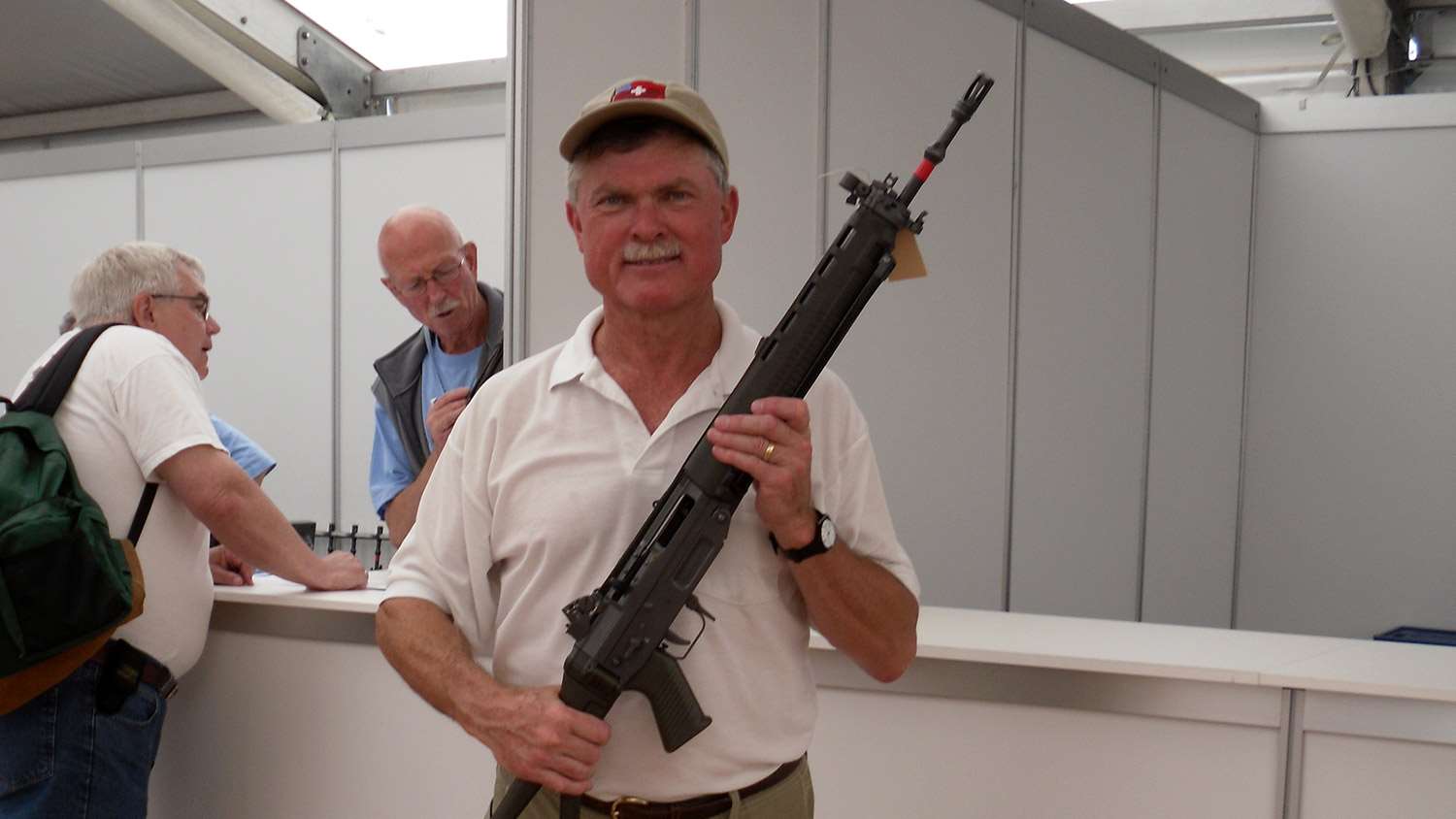
While waiting for the shuttle to the range, Sandy and I ran into Heinrich Wirz, a well-known publicist who supports the traditional militia, and Dora Andres, president of the Swiss Shooting Association (Schweizer Schiessportverband or SSV). Like Sandy, Dora is the second woman president of her nation’s shooting association.
We arrive at the Rupperswil Shooting Center, an enormous range with countless 300-meter rifle targets and Polytronic electronic target systems under covered shooting positions. While this is Militia Day, there is room for plenty of others: a young couple armed with a Stgw 90 rifle and a baby in a stroller, a middle-aged woman with designer-painted Stgw 90, and a white-haired couple, the man with a K31 bolt-action carbine and the woman with a Stgw 90. Reflecting when he did service, a middle-aged guy walks by with an Assault Rifle (Strumgewehr) 57 (7.5 cal. service rifle Model 1957). The K31 and Stgw 57 shoot the older 7.5 Swiss cartridge, which is similar to the .308 Win. cartridge.
Many Americans are familiar with the K31 straight-pull bolt-action, which has been imported in quantity in recent years along with plenty of GP-11 ammo for it. Small quantities of the semi-automatic versions of the Stgw 57 were previously imported as the PE 57 and the SIG AMT (in .308 Win.), but were banned from import in 1989 when BATF declared that these precision sporting rifles were, overnight, no longer “sporting.” The trigger pull is a little heavy, but pull out the winter trigger and you have an incredibly light two-stage trigger.
Our team is the Swiss Rifles of Washington, D.C., which won the NRA’s 1995 Most Improved Club Award for Membership Development. Each of us is issued a Stgw 90 service rifle and, for those of us shooting pistol, a SIG 210 9 mm pistol, the most accurate service pistol in the world. Each firearm is inspected and approved. We are also issued 5.6 mm Swiss ammunition, which differs little from the 5.56 mm NATO round except the bullet is jacketed lead with no steel core. The headstamp on mine is marked “T 02” (Thun 2002, made by RUAG).
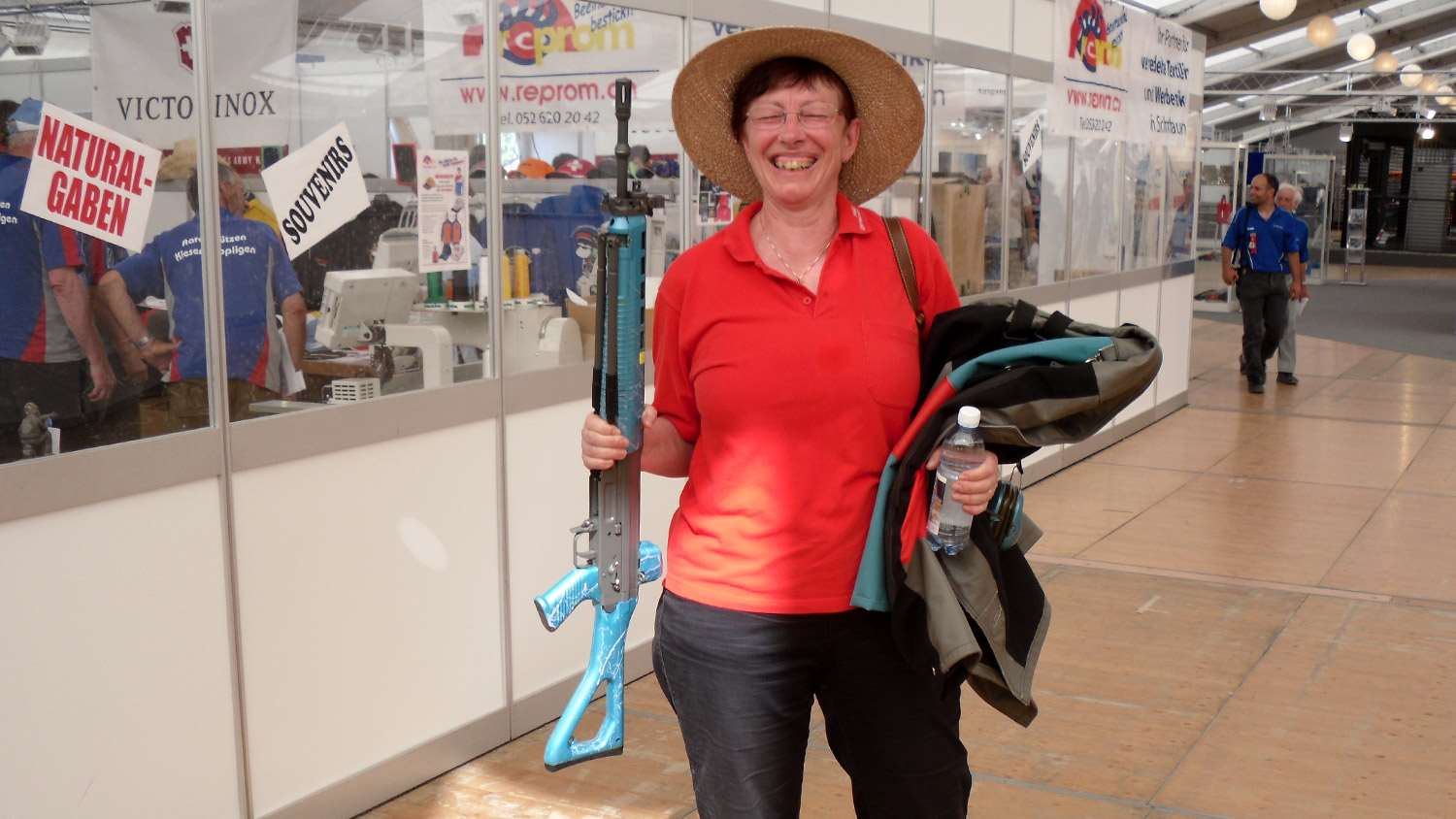
Huge tents house all manner of booths, most prominent of which is the display of scores of prizes for top shooters, from precision bolt-action rifles and designer-painted PE 90 rifles to Smart Cars and bicycles to art and carved furniture. Leading gunsmith Waffen Pauli is selling not only shooting supplies but also Stephen Halbrook’s book Schweizer Widerstand gegen Nazi-Deutschland (German translation of The Swiss and the Nazis).
ProTell, the Swiss equivalent to NRA-ILA, has a booth giving out information against the Anti-Gun Initiative, to be voted on by the Swiss people on February 13, 2011. The SVV is also well aware of the threat, as it would virtually close down the shooting sports by banning most firearms and imposing stringent registration requirements. Indeed, the initiative would dismantle the Swiss Militia Army by collecting all service arms now kept at home and storing them in arsenals. At the time of this writing, the vote has now taken place, and the gun ban was defeated by 56 to 44 percent. Traditional Swiss values were upheld, but those who wish to destroy them in favor of ordinary European statism will continue their efforts.
Switzerland is one of the safest countries in the world. Most crimes involving armed violence are committed by foreigners with illegal weapons. Ironically, the Socialist-Green proponents of the Initiative seek to disarm law-abiding Swiss while supporting unbridled immigration.
Today our team members shoot at a small range at the village of Buchs. Firing stops when a hirsch, a small European deer, meanders across the 300-meter rifle range without harm—they say it appears every day at about the same time.
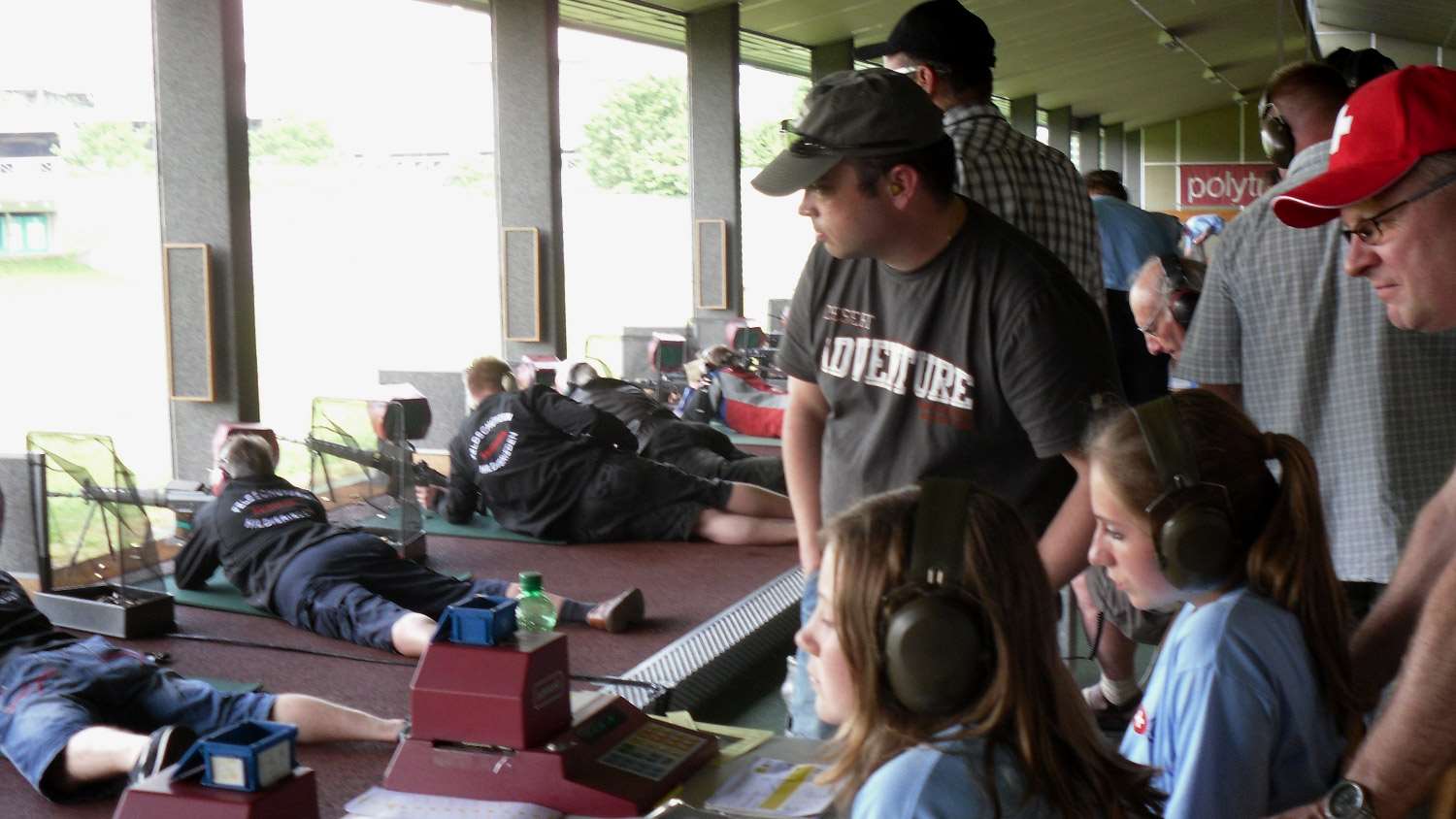
Sandy and I shoot pistol that morning, beginning with two events at 25 meters. In the Duell, a light flashes on, you raise the pistol and shoot once within 3 seconds; pause and repeat for five shots; then shoot the same string again. In the Series, you shoot five rounds in 30 seconds, then repeat.
Another two events at 50 meters: the Military, 4 slow fire, then 4 shots in 60 seconds; and the Veteran (born in or before 1950)—5 slow fire.
Traveling to a foreign country, being issued a firearm, and shooting for score after a half-dozen practice shots is, to say the least, challenging. With my pistol, I had to aim about a foot low at 5:00 and it still shot high almost every time. Despite all this, I won a medal in 50-meter Veteran.
A hearty lunch in a tent with shooting club banners donning tables and rifles strewn promiscuously around. Afterwards, time to shoot the Stgw 90.
Most events require just shooting a few rounds, maybe 6 or 10. The Swiss standard is to shoot just enough rounds precisely, not to spray and pray. In a visit to Swiss military maneuvers just before World War I, the German Kaiser asked a Swiss militiaman what he would do if a German invasion force of a half-million attached the Swiss militia of a quarter-million. His reply: “Shoot twice and go home.”
Consistent with such accuracy, almost all events are in prone position. While this does not offer the versatility of our American High Power matches with off-hand, sitting, and prone at 200, 300, and 600 yards, focus on the prone position allows far larger segments of the population to participate in rifle shooting. Further, rifle ranges pervading Switzerland in its entirety are invariably at 300 meters, while in the U.S. the norm is 100 yards for typical local ranges.
The electronic targets have a screen showing exactly where you hit the target with each shot, except in Series events which shows the hits only when finished with all shots. In an hour, I shot four events—the Verein: 6 single fire, 4 series, every shot low (even the 10!); the Kunst: 5 single fire, every shot low; the Militaer: 4 slow fire, every shot low; and the Veteranen: 5 slow fire, 2 shots to left (at least they weren’t low!), 3 shots to lower left.
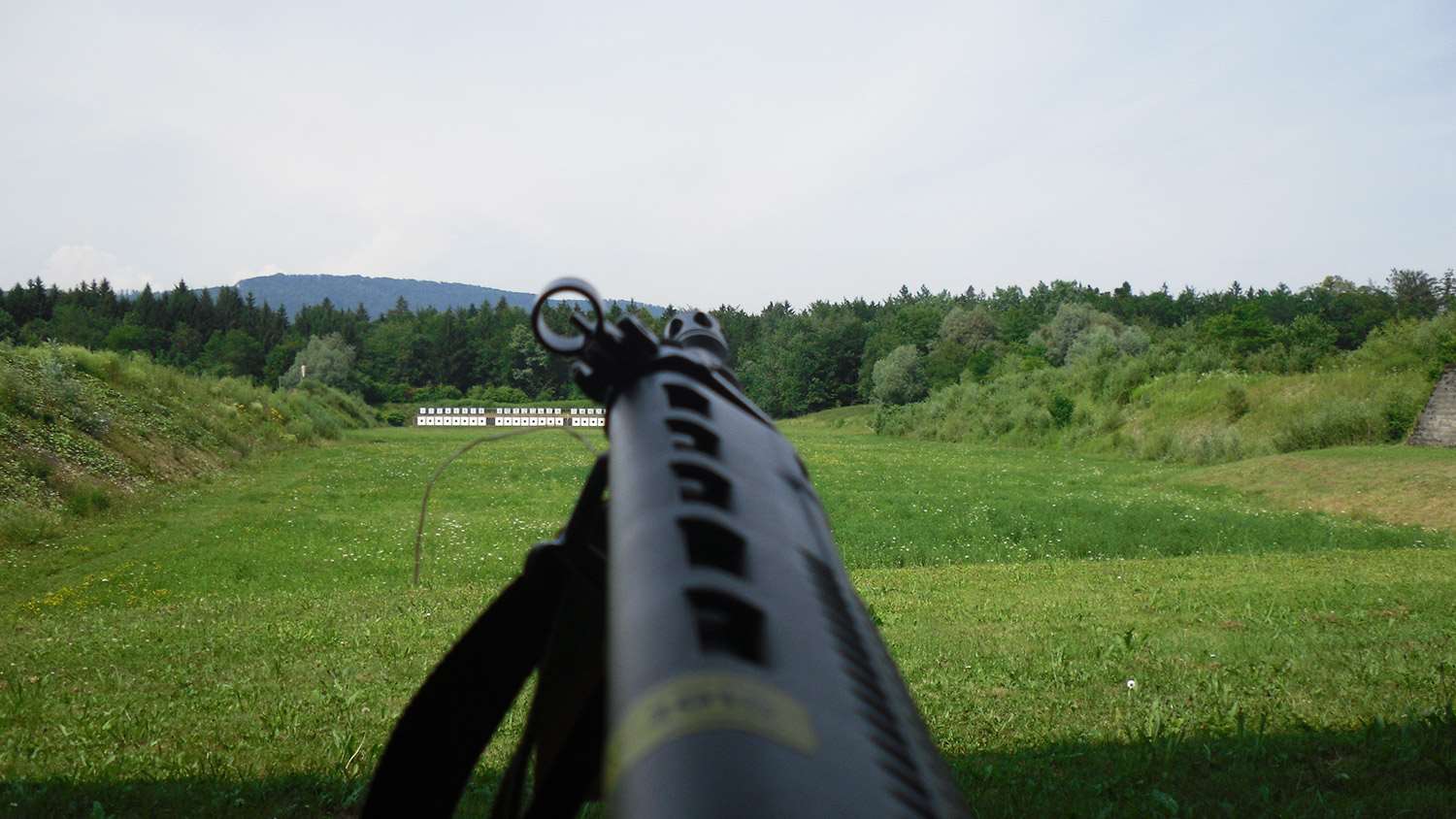
All this time, I am shooting for score, but my sights are set way too low and are being adjusted upwards ever so conservatively. Had to aim so high and cover the bull with the front sight that it is hard to see the bull! It’s taking forever to adjust the sights to go higher.
I finally got the sights adjusted correctly to shoot the Meisterschaft (Championship), the only event with lots of shots—60 to be precise. Half are in prone, half in kneeling. I shoot prone in three strings: 5:11 pm: 10 shots good (averaged 8 or 9 of 10 possible); 5:17 pm: 10 shots great (four 10s—the ultimate excitement!), five 9s, and—what the hey!—a 6; and 5:23 pm: 10 shots just okay (7s through 10s). I took no breaks between strings. Lesson: take a break after second string.
July 2: Each day has been hot, hotter, and now hottest. This part of Switzerland is definitely not in the Alps, where one can wander around glaciers and stay cool.
This morning is kneeling position in the Meisterschaft event, consisting of three strings of 10 shots each. I shot two strings in 10 minutes, took a 20-minute break, then the third string. Scores drop dramatically from prone, but kneeling isn’t the most stable position.
Shooting air gun in kneeling position most nights since Winter paid off. Total score: 474, winning the Distinction Medal. In the U.S., we don’t normally shoot kneeling in High Power Rifle. With left elbow on left knee, I found the best stability by sitting on my flattened right foot—not on my toes and not on a cushion. Sink into relaxation and don’t let that muzzle dance the jitterbug.
Next up was lunch with Richard Munday, the president of the British Alpine Rifles, and his teammates. Pity the Brits, whose government banned most guns (after the Two Big Ones, wonder when they’ll need ours again?). Members of the club must store their guns in Switzerland, a free country, and go there to shoot them. Thank goodness for the American Revolution, which found inspiration in the Swiss—peasants with no monarch who for centuries defeated the massive armies of the Austrian, French and German empires.
That afternoon, I shot as an honorary member of the shooting club of Laufenburg, a medieval town on the Rhine bordering Germany. Six single shots, 4 series shots. Score 81: missed a medal by one point!
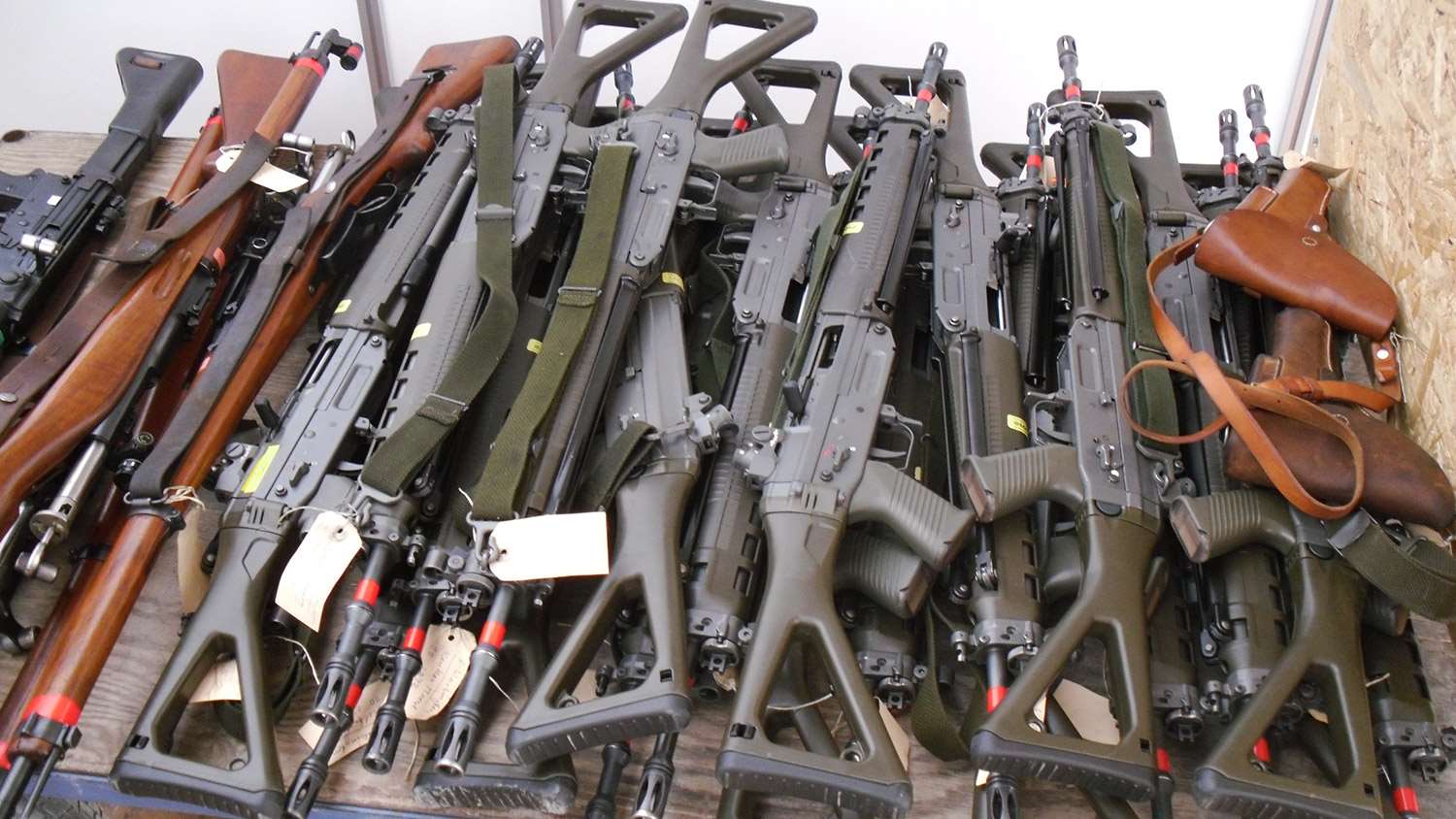
July 3 is Swiss Living Abroad Day, numbering 250 competitors representing 23 clubs, including our own Swiss Rifles of Washington, D.C. (the largest group with 24 competitors), together with clubs from Vancouver, Cape Town (the winner), Amsterdam, Los Angeles and others. This competition was at a small range at Suhr, one of the countless ranges typically found in every village. I lost count over twenty years of how many shooting ranges I have seen in Switzerland just from a train or the road, but I’ve only seen one golf course—and it was next to a shooting range.
Trees shield us from the sweltering sun as we shoot though triangular tunnels designed to suppress noise—alleviating complaints from some neighbors who prefer just to hear cow bells (I prefer the melody of bells and rifle fire together). The program: 5 practice, 6 slow, and 4 series shots.
At lunch, we hear from SSV President Dora Andres, who focused on the need to defeat the “Initiative Against Weapon Misuse”—code words for banning guns by law-abiding citizens and the militia. Pump shotguns, handguns, and semi-automatics would be banned, possession of all firearms would be subject to onerous restrictions, and Switzerland’s Militia Army would be virtually disarmed. The Initiative will be voted on by the entire population—Swiss democracy includes voting directly on laws, not just candidates. May it be soundly crushed to demoralize its supporters and to preserve freedom for generations to come.
July 4: What a great day to celebrate the right to bear arms as the hallmark of freedom in America’s “Sister Republic”—a term used by a Swiss political leader in a letter to Benjamin Franklin, noting that the Swiss had 13 Cantons and the Americans had 13 States. Thousands converge on the town of Aarau, where shots from 19th century artillery announces the opening of the festivities. The highlight of the speeches by SSV leaders and various politicians was the closing words uttered by Swiss Federal President Doris Leuthard: “Gut Schuss (good shooting)!”
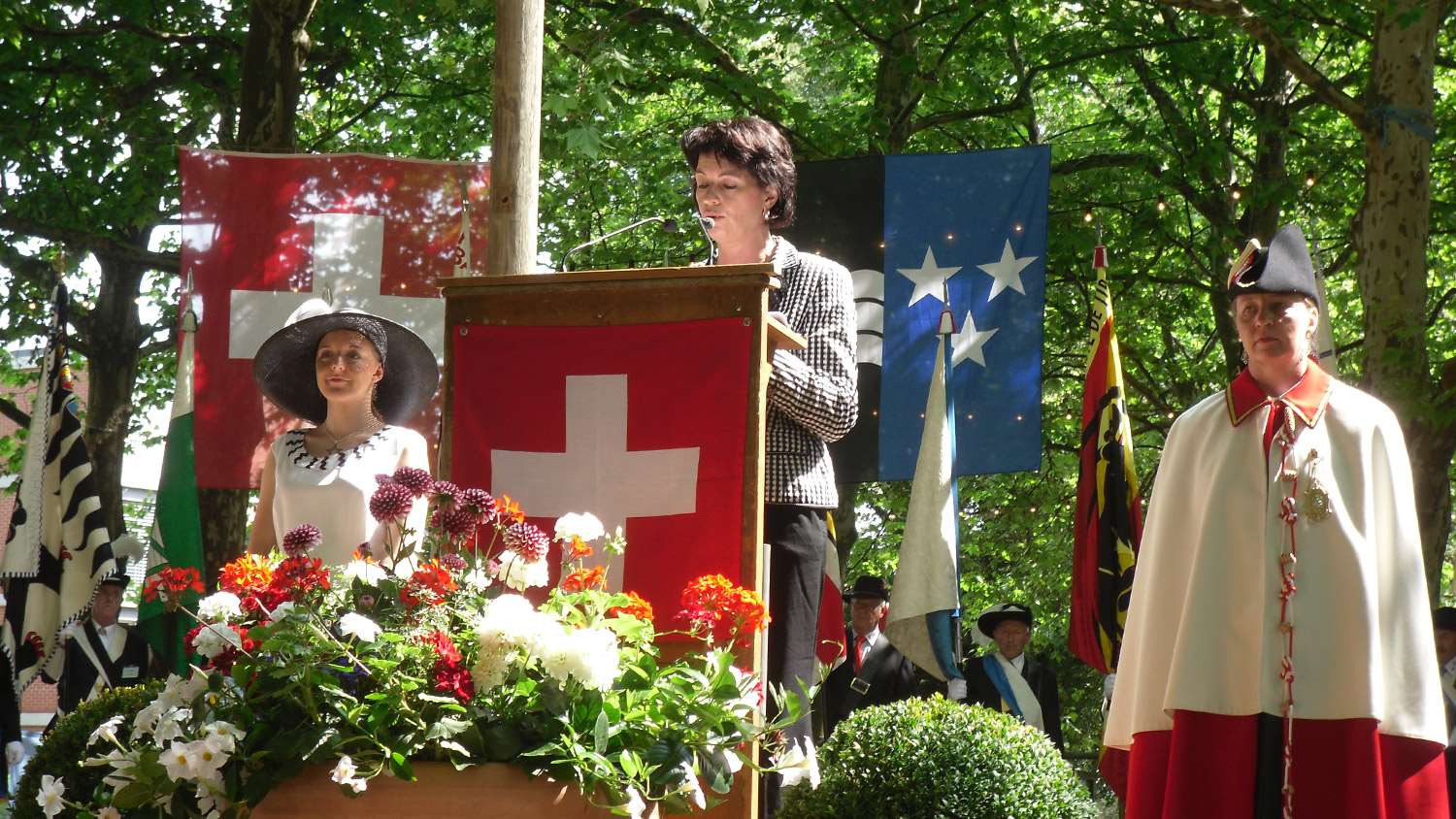
Can you imagine the U.S. President saying that? Washington, Jefferson, Teddy Roosevelt, or Reagan maybe, but who else? By the way, Switzerland is so democratic that the office of President is no big deal—half the population wouldn’t know his or her name. Patrick Henry warned against too much executive power when he noted in debates on our Constitution that the Swiss militia defeated every European monarchy which attacked, yet “those virtuous and simple people have not a mighty and splendid President.”
After the speeches ended, we walked toward the starting point of the parade, passing Aarau’s impressive monument to marksmen, a memorial showing one man with a percussion Schuetzen rifle shaking hands with another with a Schmidt-Ruben 1911 military bolt-action rifle. The monument was built in 1924 to commemorate the first Federal Schuetzenfest in 1824. The symbol for our Schuetzenfest reflects societal progress: a woman with a precision sport rifle shaking hands with a man with a Stgw 90.
The grand parade that afternoon featured seven centuries of Swiss history with thousands of marchers, all in period dress, from William Tell with crossbow and his son and military units of all ages—Roman, medieval, and modern—through farmers, vintners, politicians and every manner of shooting teams today. Our Swiss Rifles club marched behind a WWII jeep driving a 5-year old boy with a general’s hat.
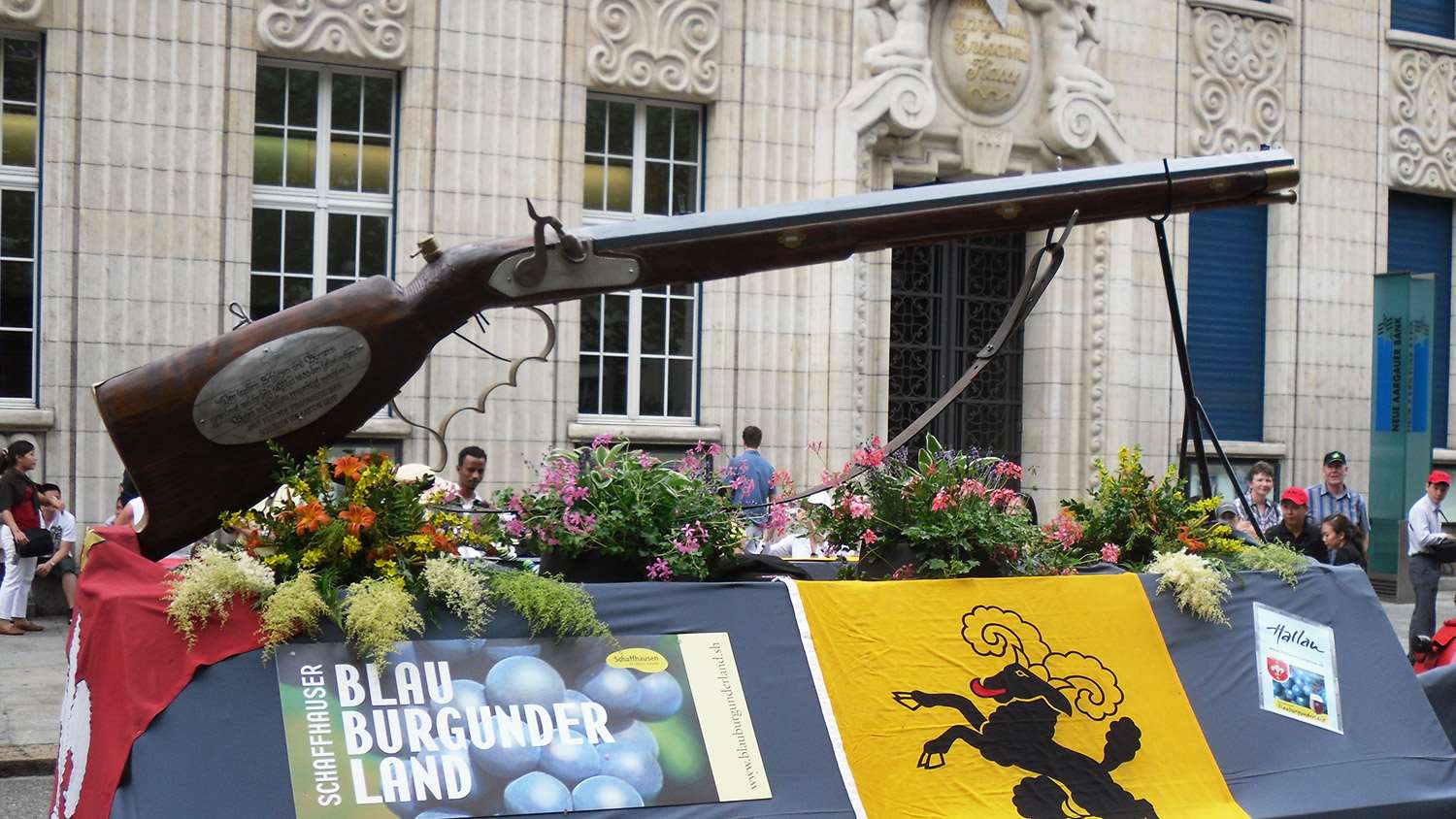
Some favorites: a giant Schuetzen rifle, bicycle troops pulling an anti-tank gun and carrying assault rifles with mortar. Horse troops with the Stgw 57 assault rifle in leather scabbards. But most of all, the girls and boys of the Lenzburg Cadets marching with their .22s—the same ones I saw riding bikes with their rifles a few days before. (See the Lenzburg Cadets in the photo at the top of this article.)
The parade was shown on Swiss TV. The major Swiss newspapers covered the Schuetzenfest events. When’s the last time you saw that in the U.S.?
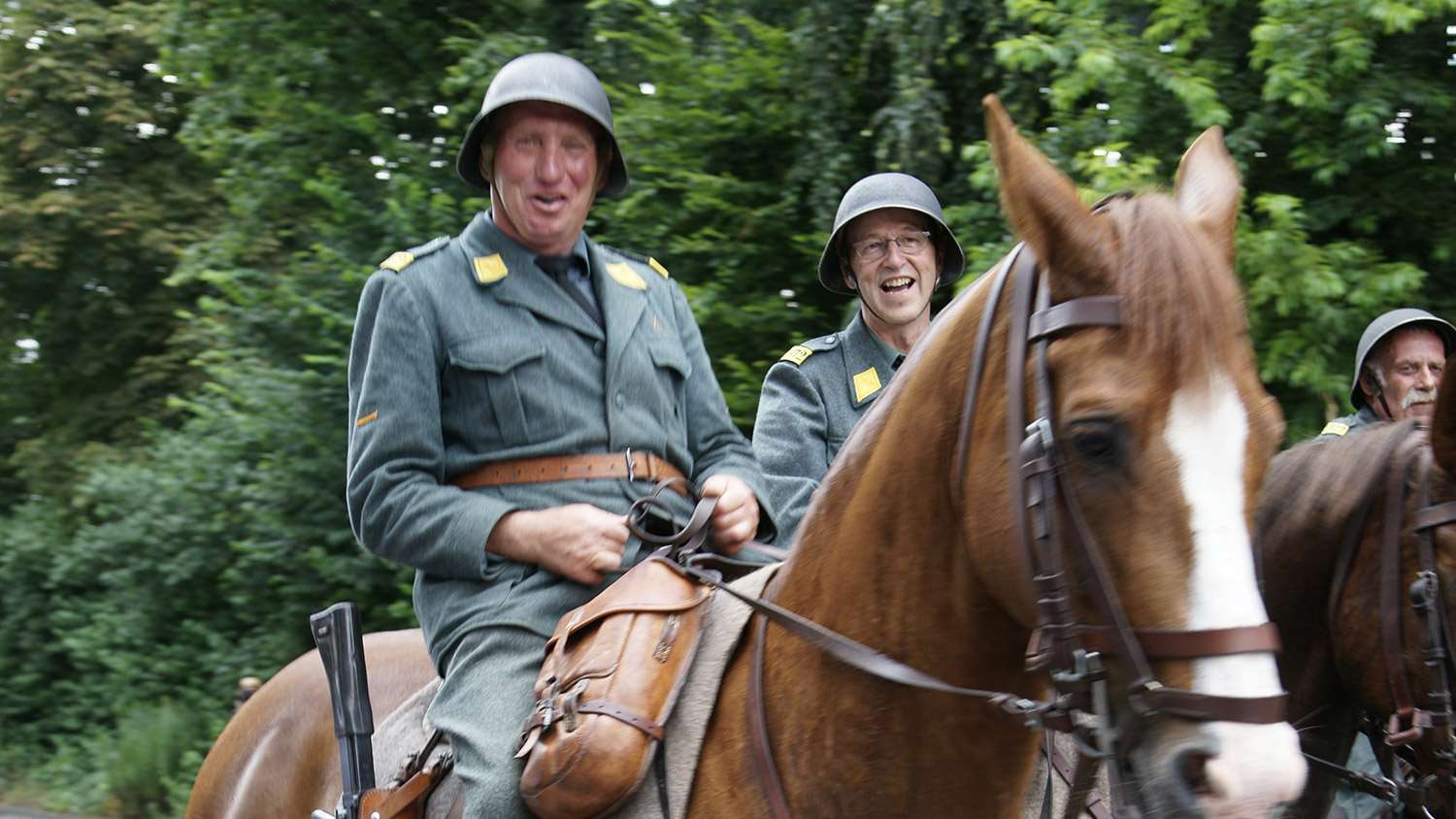
Even the ubiquitous McDonald’s advertising signs pictured three targets with the bullseyes being the silhouettes of a burger, a drink, and an ice cream, along with the words, “Now just a shot at the yummy target.”
Illustrative of the wide public acceptance of the shooting sports, the Shooting Book issued to every competitor consists of 195 pages of events, shooting programs, and advertisements—supermarkets, beer, wireless, banks, lottery, automobiles and numerous other businesses. It begins with a welcome from Ueli Mauer, head of the Swiss Department of Defense who also shot in the matches, paying homage to the role of the shooting tradition in maintaining a free society.
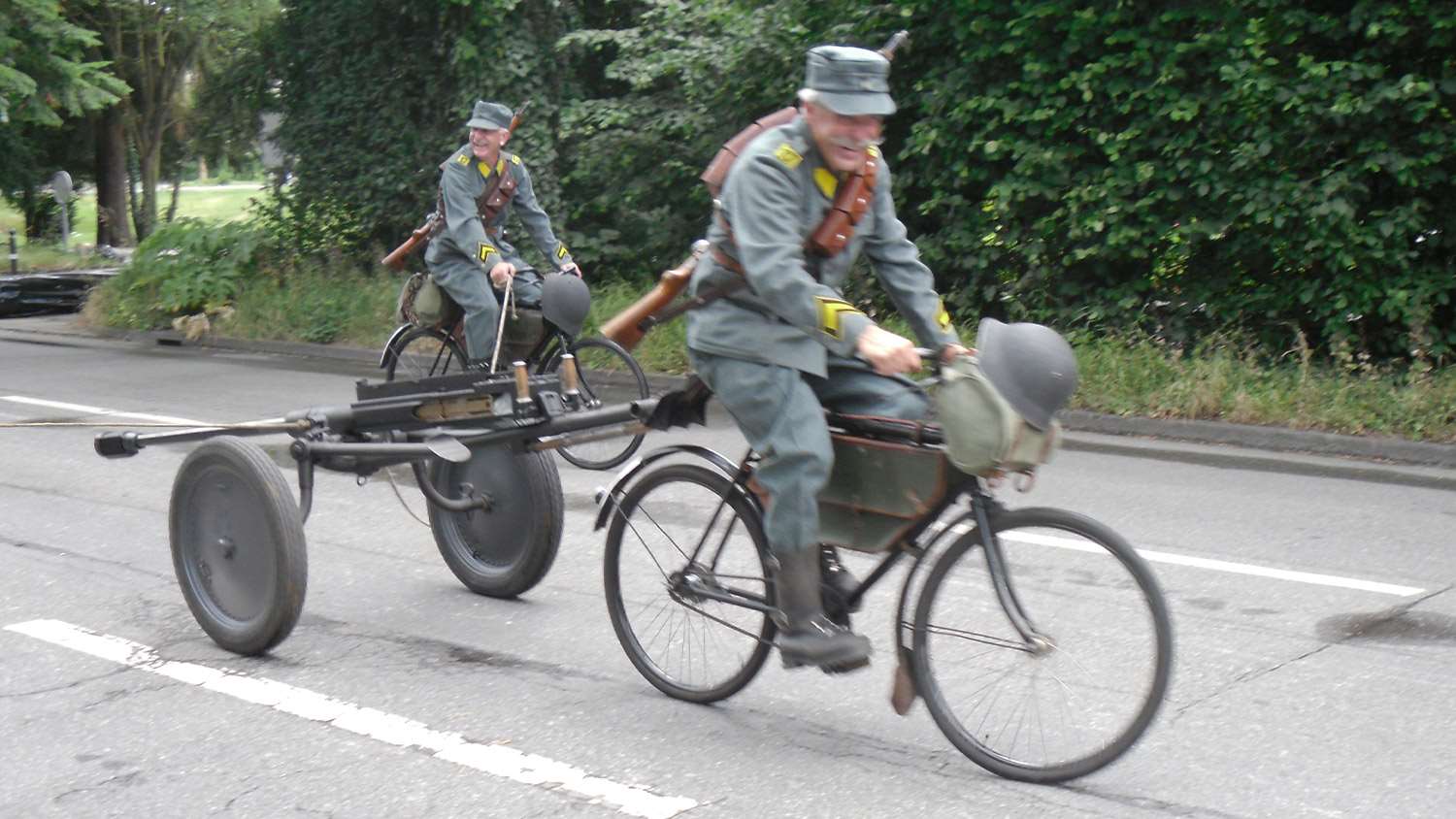
The month-long Schuetzenfest ended with the competition for top shooters. It is said that there has never been a king in Switzerland with one exception: the Schuetzenkoenig (Shooting King), the grand champion. Actually, there are now four of them to be exact: one each in military rifle, sport rifle, military pistol and sport pistol.
Teddy Roosevelt, in his 1906 state of the union address, extolled expansion of shooting ranges and rifle clubs throughout America, adding: “The little Republic of Switzerland offers us an excellent example in all matters connected with building up an efficient citizen soldiery.” He collaborated in the book Why School Boys Should Be Taught to Shoot? with NRA co-founder Gen. George Wingate, who wrote: “Switzerland has no regular army, but depends for her defence on her riflemen … Out of a population of but three million—less than that of the City of New York in 1904, she had 3,656 rifle clubs with a membership of 218,815, who shot 21 million cartridges with the army rifle.”
Hopefully Switzerland will continue to be a democratic beacon, to America, Europe and the world—where from the Alps echoes: “Gut Schuss!”
Stephen P. Halbrook, in addition to his Second Amendment books, is author of Target Switzerland and The Swiss and the Nazis. Visit StephenHalbrook.com.
See more: A Competitor’s Story: Barbara Schläpfer













